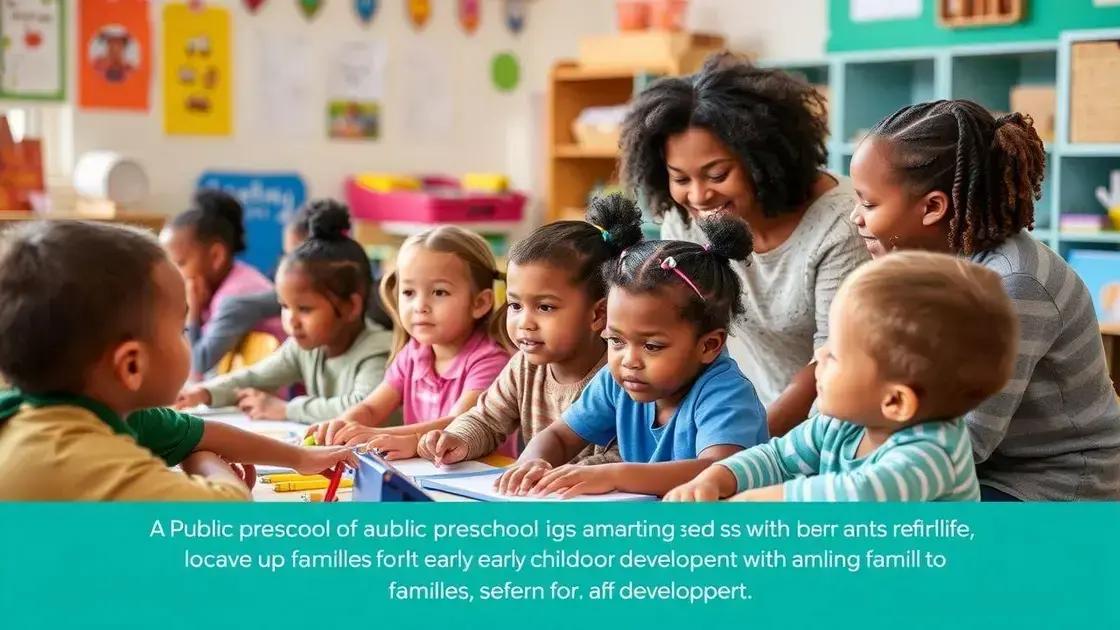Head Start program elimination: what’s at stake?

The elimination of the Head Start program poses significant risks to early childhood education, particularly for vulnerable communities reliant on its resources for comprehensive development and academic readiness.
Head Start program elimination has stirred a lot of debate lately. Many wonder how this decision will shape the lives of children and families who rely on it. Have you thought about the far-reaching effects?
Understanding the Head Start program
Understanding the Head Start program is vital to grasping the potential impacts of its elimination. This program has been instrumental in providing early childhood education to children from low-income families. By offering nurturing and structured environments, Head Start helps to ensure that children are ready for school and have the skills they need to succeed in life.
One major aspect of the Head Start program is its holistic approach. This means it not only focuses on education but also addresses health, nutrition, and family services. Such comprehensive support is essential for children who may lack these resources at home.
Key Components of Head Start
The Head Start program includes several important features that contribute to its success:
- Early education: Interactive learning experiences that promote cognitive and social skills.
- Health services: Regular health checkups and immunizations to ensure children’s well-being.
- Parental involvement: Encouraging parents to participate in their child’s education, fostering a partnership between families and educators.
- Nutrition programs: Providing healthy meals and teaching families about nutrition and wellness.
Moreover, Head Start is designed to be inclusive. Children with special needs receive tailored support to help them thrive alongside their peers. This inclusion is pivotal for fostering a sense of community and acceptance from an early age.
Despite its challenges, the program continues to positively affect the lives of countless families. Understanding its multifaceted nature helps highlight why its possible elimination could be detrimental to many vulnerable communities.
Reasons behind the proposed elimination

The reasons behind the proposed elimination of the Head Start program are complex and multifaceted. Advocates argue that funding cuts and shifting political priorities threaten the future of early childhood education. This program has become a target amid broader budgetary constraints, and many fear that eliminating it could lead to significant setbacks for children in need.
One prominent reason often cited is the belief that there are alternative education methods that could prove more effective. Policymakers argue that these alternatives might better serve the same population. However, this perspective overlooks the unique benefits that Head Start provides.
Budget Constraints
As funding for social programs continues to be debated, Head Start faces cuts that impact its operations. This is a major factor in the discussion surrounding its elimination. Reducing support for programs like Head Start affects not just education but also the health and well-being of families who rely on its resources.
- Political priorities: Different administrations may prioritize varied educational approaches, leading to shifting resources away from Head Start.
- Perceived effectiveness: Some lawmakers believe funds could be used for other education initiatives that they view as more beneficial.
- Economic pressures: Struggles to balance budgets can lead to tough decisions on where to allocate limited resources.
Another reason is the political climate and the changing views on federal involvement in education. Many see the elimination of programs like Head Start as a way to push for more local control and less federal government oversight. This perspective can lead to unintended consequences, especially for vulnerable populations.
Moreover, some critics argue that Head Start hasn’t demonstrated sufficient long-term success in educational outcomes. They suggest that funding should support programs that guarantee measurable improvements. However, while immediate results can be hard to quantify, the nurturing and development that Head Start fosters in young children often show benefits later on.
Impact on vulnerable communities
The impact on vulnerable communities due to the potential elimination of the Head Start program is profound and alarming. Many families in low-income areas rely on this program for crucial educational and social resources. Losing such support would disrupt the stability that allows children to thrive.
Head Start provides a foundation for early learning, crucial for children growing up in at-risk environments. Without it, these children may fall behind their peers in terms of cognitive, social, and emotional development. Families facing economic hardships often lack access to educational tools, making Head Start essential for bridging that gap.
Consequences of Program Elimination
The elimination of the Head Start program can lead to several negative consequences for vulnerable communities:
- Increased educational disparities: Without Head Start, children may start school unprepared, making it difficult to catch up with their peers.
- Reduced family support: Many families receive vital services through the program, such as counseling and nutrition assistance.
- Long-term financial impact: If children do not receive proper early education, this can lead to decreased earning potential in adulthood.
- Worsening health outcomes: Many Head Start programs also provide health screenings and services, which are essential for early detection of issues.
Moreover, the communities most affected by the elimination of Head Start often experience higher rates of poverty and unemployment. These factors create a cycle of disadvantage, making it even more critical to provide supportive programs for children and families. The benefits of Head Start extend beyond the classroom, impacting family welfare and community vitality.
Additionally, the emotional toll on families cannot be overlooked. The uncertainty surrounding the elimination of such a vital program can create stress and anxiety for parents. They may worry about their children’s future and their own ability to provide necessary support. This can lead to diminished well-being and stability within families, which in turn affects children’s development.
Alternatives to the Head Start program

There are several potential alternatives to the Head Start program that aim to support early childhood education and development. While these alternatives may offer different approaches, they serve a similar purpose: to prepare children for success in school and life. Understanding these options can provide insights into how communities might adapt if Head Start were to be eliminated.
One key alternative involves increasing funding for public preschool programs. Many states have introduced publicly funded pre-K initiatives to provide high-quality education for young children. These programs can offer structured learning environments similar to those found in Head Start, helping prepare children academically.
Effective Early Learning Models
Another alternative is the implementation of community-based early learning centers that focus on comprehensive child development. These centers often provide a range of services that benefit both children and families:
- Educational programming: These centers emphasize learning through play, nurturing creativity and social skills.
- Family support services: Providing resources such as counseling and job training to help families thrive.
- Nutritional support: Ensuring that children receive healthy meals helps in their overall development.
Additionally, some regions are exploring the expansion of home visitation programs. These programs send trained professionals to families’ homes to provide guidance on parenting, child development, and early learning strategies. Such support can empower parents to create enriching environments without formally attending a daycare or preschool.
Moreover, some argue for increased flexibility in funding, allowing money to be allocated to local solutions that meet the specific needs of communities. This approach encourages innovation and can lead to the development of new, effective programs tailored to local circumstances.
While these alternatives have merit, it’s important to consider that each option comes with its own set of challenges. Quality and accessibility should remain a priority to ensure that all children receive the support they need for a bright future.
Voices from affected families
Listening to the voices from affected families provides valuable insights into the real impact of the Head Start program’s potential elimination. Many families depend on this program for crucial educational and social resources. Their experiences highlight the importance of early childhood education.
For parents, Head Start often represents hope and opportunity. Parents express how the program has helped their children develop essential skills for school and life. They appreciate the emphasis on social-emotional learning, which supports children’s mental well-being alongside academic growth.
Real Stories from Families
Families repeatedly share their stories of struggle and resilience. Here are some common themes:
- Improved social skills: Parents notice significant changes in their children’s ability to interact with peers, thanks to the group activities in Head Start.
- Academic readiness: Many children enter kindergarten more prepared after attending Head Start, with foundational skills in literacy and numeracy.
- Community support: Parents often find a supportive network among other families and educators, creating a sense of belonging.
Some families recount challenges they face when accessing alternative resources. They worry that without Head Start, their children might miss out on critical early experiences. Parents have expressed fear that their children could fall behind if the program is cut, making it difficult for them to catch up in later grades.
Additionally, the financial burden of child care is a common concern. Parents explain how Head Start alleviates some of the pressures associated with costly early childhood education. Without it, many families might struggle to find affordable options that provide similar benefits.
Overall, these personal stories underscore the vital role that Head Start plays in shaping the futures of young children and their families. Their voices contribute to the larger conversation about the importance of maintaining such programs for vulnerable communities.
The future of early childhood education

The future of early childhood education is a topic of great importance as discussions around programs like Head Start evolve. Many experts emphasize that investing in quality early education can set the stage for lifelong learning and success. As society progresses, new approaches and innovations are emerging to enhance educational frameworks.
One potential trend is the integration of technology into early learning environments. Digital tools can support interactive learning experiences that engage young children in unique ways. Utilizing educational apps and online resources allows children to explore subjects at their own pace while enhancing their digital literacy.
Community-Based Solutions
There’s also a growing movement toward community-based solutions for education that focus on collaboration among families, educators, and local organizations. Such partnerships can provide comprehensive services tailored to the specific needs of families:
- Shared resources: Communities can pool resources to offer diverse educational programs and support services.
- Flexible learning spaces: Using various spaces for learning—including parks, libraries, and community centers—allows for creative educational approaches.
- Holistic development: Emphasizing social, emotional, and physical development in addition to academic skills creates well-rounded individuals.
Furthermore, as conversations around early childhood education continue, advocacy groups are pushing for policies that prioritize funding for these crucial programs. Ensuring that all children have access to quality education, regardless of their background, remains a central goal. This movement recognizes that early investments can lead to significant long-term benefits for individuals and society as a whole.
Ultimately, the evolution of early childhood education will depend on our commitment to innovation and equity. As we explore new models, it is crucial to maintain focus on the individual needs of children and families. Listening to their voices will drive the changes necessary to create the best learning environments for future generations.
FAQ – Common Questions about the Head Start Program and Early Childhood Education
What is the Head Start program?
The Head Start program is a federal initiative that provides early childhood education, health, and nutrition services to low-income children and families, helping to prepare them for school.
Why is Head Start important for vulnerable communities?
Head Start plays a critical role in addressing educational disparities, offering children in low-income families access to quality early education and essential services that support their development.
What are some alternatives to the Head Start program?
Alternatives include public preschool programs, community-based early learning centers, and home visitation programs that aim to provide similar educational and support services.
How can families get involved in their child’s early education?
Families can actively participate by engaging with educators, attending meetings, and supporting learning activities at home, which helps reinforce the skills their children are developing.






